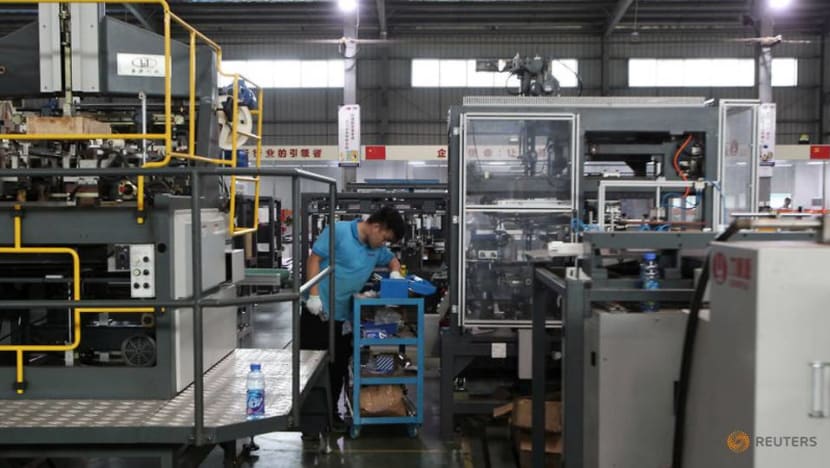commentary Commentary
Commentary: Why aren’t more Singapore businesses transforming? Mindsets aren’t the key obstacle
SBF CEO Ho Meng Kit says digital transformation today really boils down to two things - talent and understanding technology.

Workers in Raffles Place, Singapore. (Photo: AFP)
SINGAPORE: By now, most, if not all, companies in Singapore would agree digital transformation is no longer an option.
Integrating digital technology into aspects of a businesses to fundamentally change how they operate and deliver value to their customers is what’s needed to survive and thrive.
As early as 2010, the Government has been urging companies in Singapore, including small- and medium-sized enterprises (SMEs), to transform their businesses in order to stay relevant and competitive.
Numerous initiatives like the now defunct Productivity and Innovation Credit scheme, Technology Adoption Programme and SMEs Go Digital Programme, which provides incentives and resources for SMEs to invest in automation, robotics and other technology solutions, have also been rolled out over the years.
Nearly 10 years on, the message has come through loud and clear, with companies, both big and small, responding to the call.
READ: Worst may be over for Singapore economy but recovery will be sluggish, say experts
A SHIFT IN MINDSET IS UNDERWAY
SBF’s annual National Business Survey shows that the importance of business transformation has gained considerable ground among companies.
In 2016, only 15 per cent of Singapore SMEs surveyed strongly agreed with the need to transform to counter slowing economic growth and technological change. Among large companies, the message resonated twice as strong but this was still a low number.
Today, nine in 10 recognise the importance of business transformation to remain relevant and competitive, as the world becomes increasingly digital.
READ: Commentary: Singapore and the dreaded R word - recession

In 2018, more than half of Singapore companies reported implementing some form of business innovation, but findings revealed that smaller companies were less likely to innovate — larger businesses reported a higher rate of implementing new technologies (40 per cent) compared to SMEs (31 per cent).
Awareness, clearly, has not quite translated into action. Why are companies sitting on the sidelines when doing nothing means taking a bigger risk?
BRIDGING THE DIGITAL TALENT GAP
Years since companies began marching to Singapore’s digital transformation drum beat, the key challenges hindering businesses in their transformation efforts today boil down to talent and technology, our research reveals.
This echoes a 2018 Cisco study which shows that most companies in Asia are slow to adopt technology due to budget constraints, a lack of adequate talent and an unfit IT infrastructure.

The growing demand for digital skills in the workplace has resulted in a talent deficit in Singapore’s tech sector, despite the Government’s push to encourage students to pursue careers in science, technology, math and engineering.
Demand for technology jobs in Singapore rose by 20 per cent the past year, according to a 2019 salary benchmark report by recruiting firm Michael Page.
For businesses, especially SMEs, this tech talent crunch presents a huge problem. Coupled with a tight foreign quota, the high demand across sectors has driven up wages and salary expectations.
READ: Commentary: The future is tech but where is Singapore’s engineering and IT talent?
This puts pressure on smaller companies who find it harder to hire talent with this right set of skills when competing against larger, more established outfits with better learning and development opportunities and benefits.
If there aren’t enough people to fill the gaps, companies need to explore other ways – over and above hiring – to overcome the problem.
INVESTING INTERNALLY
For one, they need to start investing in their existing workforce and look at ways to develop talent internally.
This means ensuring employee access to quality digital skills training, while also encouraging a company culture of continuous learning and providing employees opportunities to take on roles that are more valued-based and rewarding. Not only will this help employees prepare for the jobs of tomorrow, it will drive innovation in the company.

Key to success is also anticipating digital trends so that training remains relevant and useful not just for the jobs of today but also the jobs of the future.
In this regard, institutes of higher learning and companies can look to win-win partnerships.
READ: Commentary: In this tough job market, retraining alone is no silver bullet
Take for example, Singtel’s info-communications technology solutions provider subsidiary, NCS, which has joined hands with the National University of Singapore's Institute of Systems Science to train more than 1,000 digital ICT employees and new hires over the next two years.
Apart from providing technical training for mid-career NCS employees and training for new software engineers, the collaboration allows NCS's subject matter experts to teach in the institute, while NCS offers internship and project opportunities to its students.

Trade Associations and Chambers (TACs) and industry leaders can also play a leading role. Specific to industry needs, they can reap benefits of scale to set up digital academies which can effectively support the digital upskilling of SME owners and their employees.
Last week, SBF announced a partnership with V3 Fintech, the digital financial services unit of V3 Group, to establish Beyond Lab, a regional academy focused on supporting SMEs in adopting digital technology to increase operational efficiency and competitiveness.
Through the academy, we hope to help our SMEs transform, and equip them to tap the opportunities of the digital economy in the region.
From digital leadership development courses to cybersecurity, data analytics and artificial intelligence, these digital academies can help smaller companies cultivate a digital culture and develop the full suite of digital capabilities they need affordably.
READ: From ice cream to chatbots – how TACs are driving transformation in Singapore, a commentary
This also gives them the flexibility to hire for potential, not just credentials. Instead of competing for people with the right skills, they can, instead, bring onboard people who can develop the skills they need.
TACKLING THE TECH GAP
The lack of adequate talent aside, the other major challenge companies cite in our research is the cost of adopting digital solutions. Some of these companies also lack a comprehensive strategy and are unsure of which solution to adopt, and where or how to deploy it to their best advantage.
One of the biggest misconceptions among companies, perhaps, is that digital adoption is expensive and something only big companies can afford.

But companies can start small. It could be as simple as getting on social media or setting up a website, which can spark more experiments with digital technology as these firms grow in experience, competence and confidence.
For a start, SMEs can leverage the Infocomm Media and Development Authority’s (IMDA) SMEs Go Digital Programme.
The programme offers a self-assessment tool as well as a Start Digital pack where SMEs can adopt any two solutions ranging from accounting and digital marketing to cybersecurity and digital transactions at a lower cost.
The SME Portal’s Tech Depot also has a wide range of readily adoptable technology solutions. Companies can also tap on other schemes such as the Enterprise Development Grant and the Productivity Solutions Grant for more complex projects which may require significant investment upfront.
HELP IS AT HAND
To address some of these issues, the SBF Digitalisation Committee, led by Janet Ang, SBF Council Member and former Vice President of Industry Solutions and Business Development at IBM Asia Pacific, ramped up its efforts this year to show companies what they can readily do to embark on their digitalisation journeys.

These include industry-specific forums and the SBF-SMEs Go Digital “Leaders for Transformation” Series which shed light on the strategies detailed in the Industry Transformation Maps, and the Industry Digital Plans and showcased businesses who have successfully digitalised.
SBF is also partnering the NUS Institute of Systems Science to offer a suite of Digital Transformation programmes to upskill companies and their workforce.
READ: Commentary: Why aren’t there more Singaporean CEOs?
Former General Electric CEO Jack Welch once said: “If the rate of change on the outside exceeds the rate of change on the inside, the end is near.”
Now that businesses realise they need to align themselves with how the world has change, they have a choice to make – lead the pack, match the pace of change or fall behind. Doing nothing is no longer an option.
Ho Meng Kit is CEO at Singapore Business Federation.












